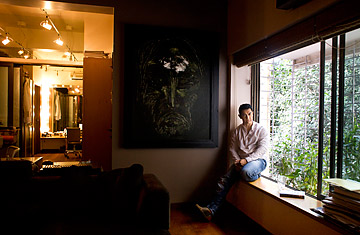
Portrait of Aamir Khan at his residence in Pali Hills, Mumbai, June 8, 2012
(2 of 4)
Nobody questions, however, that Khan has forced his audience to confront unpalatable truths about Indian society. Even journalists with a long track record of covering social problems acknowledge that Khan's star power has helped make people sit up and listen. "We've been covering these issues for years," says Richa Anirudh, the anchor of Zindagi (Life) Live, a Hindi-language news show that tackles themes almost identical to Satyamev Jayate's. "But when [Khan] brings them up, they naturally get more attention."
The Bollywood Identity
Can a movie star affect the mores of a nation of 1.2 billion? It might just be possible in India, where a national obsession with cinema, unparalleled in the world, gives popular actors an influence beyond the imagination of Hollywood scriptwriters. Indians are voracious movie watchers: collectively, they buy over 4 billion cinema tickets every year and watch over 1,200 films in a dozen languages. (In comparison, the average annual output of Hollywood's major studios and subsidiaries in the past decade is barely 180, with Americans buying 1.28 billion tickets a year.) Scores of Indian TV channels deliver an unending supply of reruns, and pirated DVDs of current releases as well as classics sell in the millions.
But you don't have to be in front of a screen, large or small, to come under the thrall of Bollywood. (The term, originally attached to Hindi-language movies made in Bombay, or Mumbai, is often used to describe all of Indian cinema.) Giant billboards advertise the latest releases or feature movie stars endorsing everything from automobiles to mouth fresheners. Every day of the year, readers of major Indian newspapers receive an eight- to 16-page supplement of cinema-heavy celebrity coverage.
All of this adds up to a national culture of fanatical star worship: only Brazil's adoration for its top soccer players comes close. "If you're a movie star in India, you're both a god and a favorite child," says Anil Kapoor, who had enjoyed that status long before international audiences saw him as the swaggering quizmaster in Slumdog Millionaire. "People give you incredible reverence, but when they talk about you, they use your first name, like you're a member of the family."
Yet, for all their outsize influence, Bollywood's biggest stars rarely embrace causes, even uncontroversial ones. There is no Indian equivalent, for instance, of Jerry Lewis' telethons for muscular dystrophy. Bollywood's brightest can be relied on to bring glamour to fundraising parades or galas after a natural disaster. Still, no one has attempted a deep engagement along the lines of Angelina Jolie's humanitarian efforts in Africa, much less George Clooney's aggressive activism on Darfur. "Many [Indian actors] are good-hearted, but they haven't been smart or focused when it comes to causes," says iconic actress Shabana Azmi, who has spotlighted the plight of Mumbai's slum dwellers and done public-interest messages about AIDS. "Some of them do things quietly, but they say they don't want to openly attach themselves to a cause because it might be seen as going beyond their responsibility as entertainers."
"You worry that people will say, 'Your job is to give us three hours of escape from our lives, not to lecture us on how we should live,' " says Rishi Kapoor, romantic hero of the 1970s and '80s, and son of Raj Kapoor, the actor-director who made a string of films with powerful social themes in the black-and-white era. "It takes a genius like my father to find the balance between what people want to see and what you want to show them."
Reel Life
With Satyamev Jayate, Khan has torn up the unwritten compact between a star and his fans. The show makes no effort whatsoever to sugarcoat the message, and there's no concession to the audience's desires. You see what Khan wants you to see, and much of it is very, very unpleasant.
Each 90-minute episode tackles a single issue — honor killings, say, or discrimination against the disabled — with a brutal candor that has viewers squirming on their sofas. On a sparse stage before a small studio audience, the victims of India's social ills pour their heart out to Khan, who encourages them to relive their horrors. Their tales are interspersed with short field reports and discussions with experts on the scale of the problem. Khan supplies his audience with statistics compiled by a team of researchers. There's also usually an exploration of the laws pertaining to the issue and a can-do segment in which those who have overcome the predicament offer guidance to those still enduring it.
